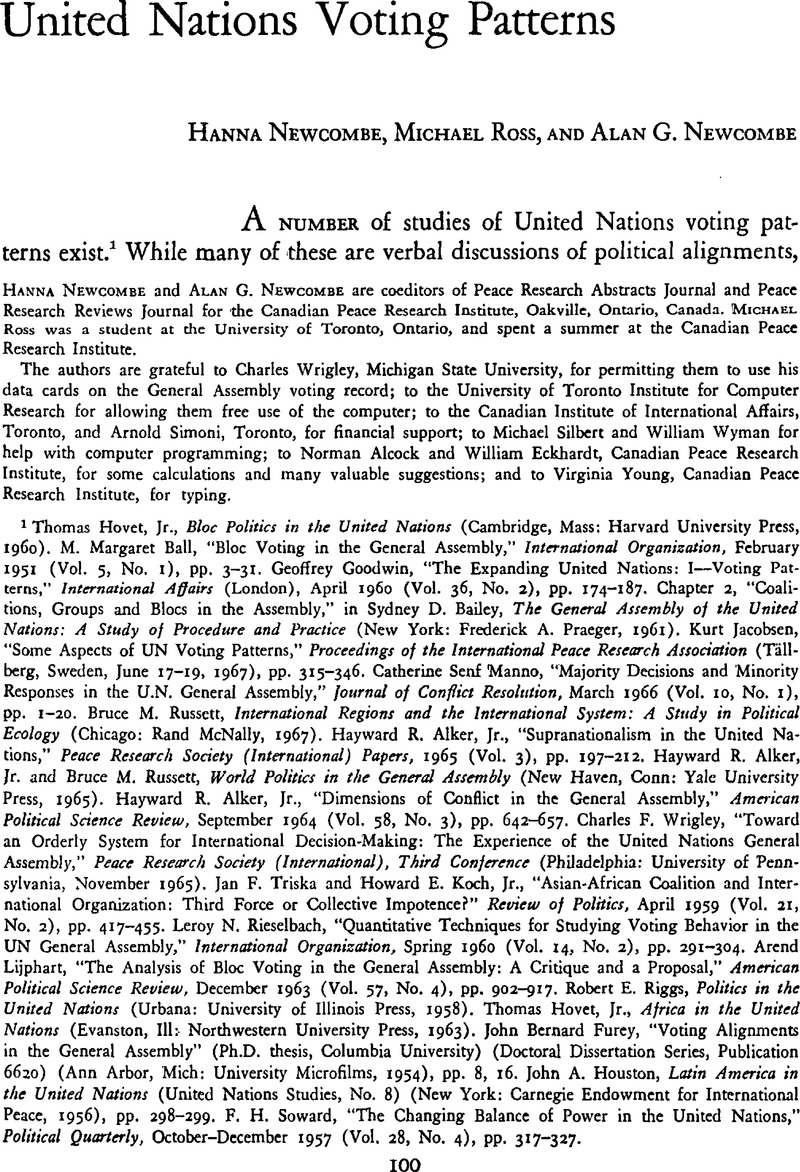Article contents
United Nations Voting Patterns
Published online by Cambridge University Press: 22 May 2009
Abstract

- Type
- Notes on Theory and Method
- Information
- Copyright
- Copyright © The IO Foundation 1970
References
1 Hovet, Thomas Jr, Bloc Politics in the United Nations (Cambridge, Mass: Harvard University Press, 1960)CrossRefGoogle Scholar. Ball, M. Margaret, “Bloc Voting in the General Assembly,” International Organization, 02 1951 (Vol. 5, No. 1) , pp. 3–31CrossRefGoogle Scholar. Goodwin, Geoffrey, “The Expanding United Nations: I—Voting Patterns,” International Affairs (London), 04 1960 (Vol. 36, No. 2), pp. 174–187Google Scholar. Chapter 2, “Coalitions, Groups and Blocs in the Assembly,” in Bailey, Sydney D., The General Assembly of the United Nations: A Study of Procedure and Practice (New York: Frederick A. Praeger, 1961)Google Scholar. Jacobsen, Kurt, “Some Aspects of UN Voting Patterns,” Proceedings of the International Peace Research Association (Tallberg, Sweden, 06 17–19, 1967), pp. 315–346Google Scholar. Manno, Catherine Senf, “Majority Decisions and Minority Responses in the U.N. General Assembly,” Journal of Conflict Resolution, 03 1966 (Vol. 10, No. 1), pp. 1–20CrossRefGoogle Scholar. Russett, Bruce M., International Regions and the International System: A Study in Political Ecology (Chicago: Rand McNally, 1967)Google Scholar. Alker, Hayward R. Jr, “Supranationalism in the United Nations,” Peace Research Society (International) Papers, 1965 (Vol. 3), pp. 197–212Google Scholar. Alker, Hayward R. Jr, and Russett, Bruce M., World Politics in the General Assembly (New Haven, Conn: Yale University Press, 1965)Google Scholar. Alker, Hayward R. Jr, “Dimensions of Conflict in the General Assembly,” American Political Science Review, 09 1964 (Vol. 58, No. 3), pp. 642–657CrossRefGoogle Scholar. Wrigley, Charles F., “Toward an Orderly System for International Decision-Making: The Experience of the United Nations General Assembly,” Peace Research Society (International), Third Conference (Philadelphia: University of Pennsylvania, 11 1965)Google Scholar. Triska, Jan F. and Koch, Howard E. Jr, “Asian-African Coalition and International Organization: Third Force or Collective Impotence?” Review of Politics, 04 1959 (Vol. 21, No. 2), pp. 417–455CrossRefGoogle Scholar. Rieselbach, Leroy N., “Quantitative Techniques for Studying Voting Behavior in the UN General Assembly,” International Organization, Spring 1960 (Vol. 14, No. 2), pp. 291–304CrossRefGoogle Scholar. Lijphart, Arend, “The Analysis of Bloc Voting in the General Assembly: A Critique and a Proposal,” American Political Science Review, 12 1963 (Vol. 57, No. 4), pp. 902–917CrossRefGoogle Scholar. Riggs, Robert E., Politics in the United Nations (Urbana: University of Illinois Press, 1958)Google Scholar. Hovet, Thomas Jr, Africa in the United Nations (Evanston, III: Northwestern University Press, 1963)Google Scholar. Furey, John Bernard, “Voting Alignments in the General Assembly” (Ph.D. thesis, Columbia University) (Doctoral Dissertation Series, Publication 6620) (Ann Arbor, Mich: University Microfilms, 1954), pp. 8, 16Google Scholar. Houston, John A., Latin America in the United Nations (United Nations Studies, No. 8) (New York: Carnegie Endowment for International Peace, 1956), pp. 298–299Google Scholar . Soward, F. H., “The Changing Balance of Power in the United Nations,” Political Quarterly, 10–12 1957 (Vol. 28, No. 4), pp. 317–327CrossRefGoogle Scholar
2 The criterion for determining the number of factors was that the eigenvalue of each should exceed I. The factors were rotated orthogonally by the Varimax criterion.
- 27
- Cited by




